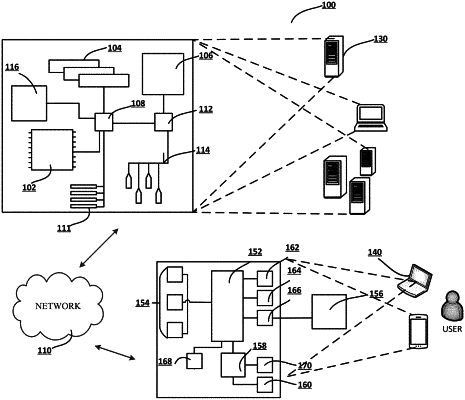| CPC G06Q 10/0631 (2013.01) | 20 Claims |

|
1. A system for intelligent allocation of resources over multiple events into an auxiliary source retainer, the system comprising:
an imaging device configured to decode machine-readable codes;
a scanning device;
a tangible-resource-dispensing system;
at least one non-transitory storage device; and
at least one processing device coupled to the imaging device, the scanning device, the tangible-resource-dispensing system, and the at least one non-transitory storage device, wherein the at least one non-transitory storage device comprises computer-executable program code comprising instructions configured to cause the at least one processing device to:
determine, using a machine learning model, a potential for exhaustion of secondary tangible resources of an entity by providing attributes of resource distributions to the machine learning model, wherein the machine learning model is trained using historical data associated with previous resource distributions to output potentials for exhaustion of the secondary tangible resources, and wherein the machine learning model comprises one or more predictive modeling algorithms configured to use data and statistics to predict one or more outcomes with one or more forecasting models;
determine whether the potential for exhaustion of the secondary tangible resources satisfies a threshold;
scan, with the imaging device, a machine-readable code;
initiate, in response to scanning the machine-readable code, a resource distribution between the entity and a user;
determine a total amount of resources for the resource distribution;
receive, with the scanning device, tangible resources from the user;
scan, with the scanning device, the tangible resources to determine that the user provided a transferred amount of the tangible resources to the entity;
determine a difference between the transferred amount and the total amount, wherein the difference comprises a primary amount of resources corresponding to primary tangible resources and a secondary amount of resources corresponding to secondary tangible resources;
prompt, based on the potential for exhaustion of the secondary tangible resources satisfying the threshold, the user to provide authorization to allocate the secondary amount of resources to an auxiliary source retainer associated with the user;
receive authorization and information identifying the auxiliary source retainer from an auxiliary resource distribution instrument provided by the user to the system;
allocate, from a source retainer associated with the entity, the secondary amount of resources to the auxiliary source retainer associated with the auxiliary resource distribution instrument provided by the user;
output, with the tangible-resource-dispensing system, the primary amount of primary tangible resources to the user;
automatically request, based on determining that the potential for exhaustion of the secondary tangible resources satisfies the threshold, additional secondary tangible resources from another entity;
determine whether a balance amount of resources of the auxiliary source retainer satisfies another threshold;
cause, based on the balance amount of resources of the auxiliary source retainer satisfying the other threshold, a third amount of primary tangible resources to be dispensed to the user; and
cause, based on causing the third amount of primary tangible resources to be dispensed to the user, the balance amount to be reduced by the third amount.
|